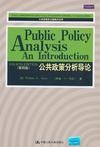公共政策分析导论
2011-3
中国人民大学
威廉·N·邓恩
382
无
《公共政策分析导论(第4版)》英文版于l981年首次出版,被译为多种语言,是公共政策研究领域公认的经典著作,也是该领域文献引用率最高的著作之一。 《公共政策分析导论(第4版)》集公共政策分析的概念与方法之大成,运用“以问题为中心的政策分析”方法架起公共政策理论与实践的桥梁,体现了作者独到的见解和深刻的认识。作者对 公共政策分析领域进行了全面的梳理和总结,从宏观到微观,深刻、系统地阐述了政策分析的方法及政策分析在制定过程中的作用和功能;同时对政策分析方法的运用进行了详细介绍,包括政策问题构建、政策前景预测、政策行动建议、执行结果监测和政策绩效评价等。《公共政策分析导论(第4版)》被公认为公共政策专业的经典教材,不仅可以使读者掌握政策分析的主体理论,而且有助于读者了解和运用政策分析的具体方法。 《公共政策分析导论(第4版)》配有中文翻译版。
作者:(美国)威廉·N·邓恩(William N.Dunn)威廉·N·邓恩(William N.Dunn),美国匹兹堡大学教授,国际知名政策分析专家。邓恩教授长期致力子教学和研究工作,同时还从事广泛的政策分析实践活动,他曾为美国联邦、州和地方政府做过大量政策分析及其他应用研究工作,并参与国内、欧盟国家、中东、北非和和南美一些国家的高级公务员培训活动。他在理论研究和实际应用方面的突出贡献使其在同行学者中享有很高的声誉。
序言第1章 政策分析过程1.1 政策质询过程1.2 跨学科的政策分析政策相关信息政策信息的转换政策分析方法1.3 政策分析的三个案例1.4 政策分析的形式回溯性分析与前瞻性分析描述性分析与规范性分析问题发现与问题解决局部分析与整体分析1.5 政策分析的实践重构逻辑与应用逻辑方法论的机会成本1.6 批判性思考与公共政策政策论证的结构论证、公共话语与辩论的动力本章小结学习目标关键术语与概念复习题参考文献第2章 政策制定过程中的政策分析2.1 历史背景早期起源19世纪的演变2.世纪2.2 政策制定过程2.3 政策模型的变化全面理性次优理性不连续渐进主义有限理性混合扫描疑问理性判别性聚敛断续性平衡2.4 政策过程中的政策分析分析的潜在作用分析的实际作用本章小结学习目标关键术语与概念复习题参考文献第3章构建政策问题3.1 政 策问题的本质超越问题解决问题的特征问题与议题政策问题的三种类型3.2 政策分析中的问题构建问题构建中的创造性问题构建的步骤第三类错误3.3 政策模型与问题构建描述性模型规范性模型……第4章 预测政策结果第5章 建议优先政策第6章 监测可观察的政策结果第7章 评估政策绩效第8章 开发政策论证第9章 政策分析的沟通
版权页:插图:Even the most simple descriptions of problem situations are based on the classification of experience through inductive reasoning, a process where general (abstract) concepts, such as poverty, crime, and pollution, are formed by experiencing particular (concrete) objects or situations. When we classify a problem situation in one way, we often foreclose opportunities to classify it in another way, as the nine-dot problem illustrates so well.Classificational analysis is based on two main procedures: logical division and logical classification. When we select a class and break it down into its component parts, the process is called logical division; the reverse process, which involves the combination of situations, objects, or persons into larger groups or classes, is called logical classification. The basis of any classification depends on the analyst's purpose, which in turn depends on substantive knowledge about a problem situation.Consider, for example, the analysis of poverty in the United States. All families in the United States may be broken down into two subclasses: those whose incomes are above and below a poverty line established by the U.S. Social Security Administration. If an analyst stops at this point in the process of logical division, he or she will reach the conclusion that poverty in the United States is gradually declining and perhaps claim that the progressive reduction of poverty is a consequence of the operation of a healthy economy. Yet when the process of logical division is carried one step further, and poverty families are divided into two additional subclasses on the basis of income before and after government transfer payments, the analyst will reach an altogether different conceptualization of the problem. Here the analyst will no doubt conclude that the reduction of poverty is a consequence of public welfare and social security programs and probably claim that problems of poverty cannot be resolved by the private enterprise system, because the number of families below the poverty line increased absolutely and relative to the total population between 1968 and 1972 (Table 3.3).
《公共政策分析导论(第4版)》:公共管理英文版教材系列。

无
英文版,教参,有点看不懂,但还是要多学习的
书挺好 就是没有仔细看 买的时候买错了 呵呵